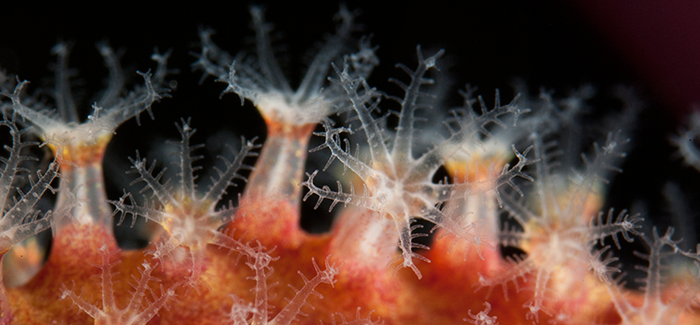
Leptogorgia hebes, the regal sea fan. (Photography by Michael LaBarbera)
Biology professor Michael LaBarbera has spent his career immersing students—and himself—in an underwater world and the unending adventure of science.
A little after two o’clock, biology professor Michael LaBarbera strides toward the front of the lab with his customary grin, the chatter in the room dies down, and 12 undergraduates fall into a cluster around him. “OK!” he says, booming, excited. He is not quite shouting. “Arthropods!” It’s a Friday afternoon, the eighth week of fall quarter, and LaBarbera’s Invertebrate Biology class, having covered mollusks, sponges, hydroids, corals, parasites, and all manner of worms, has arrived at arthropods. It is an impossibly vast phylum, encompassing lobsters and shrimp, spiders and scorpions, centipedes, millipedes, and the exquisite, prodigious diversity of insects. Taken together, arthropods account for the majority of all known living animal species—more than 80 percent, studies estimate—and occupy nearly every habitat on Earth.
Earlier in the week, LaBarbera gave two lectures on arthropods. Now he lays out the tasks for today’s lab: first, students will dissect crayfish, paying particular attention to the limbs, noting how each branches out from the base like a Y, how different appendages share a similar architecture up and down the body, all drawing on the same ancestral pathways and gene cascades, which eons ago coalesced to build fins and, later, legs.
Then, a horseshoe crab dissection, lifting up the carapace to study the long thin tube of the heart, the gut nestled beneath it, the muscles that control the legs. There are also microscope slides of insects to examine—lice, mosquitoes, bed bugs—and a collection of trilobite fossils. Horned and beetle-like, with their wide bodies and furrowed backs, trilobites were among the planet’s most prosperous early animals; they disappeared at the end of the Paleozoic, in a mass extinction that killed off more than 90 percent of all marine life.
Finally, LaBarbera introduces the live animals. The petting zoo. This is where the most boisterous learning happens, and some of the best, as students interact with moving, breathing creatures; watch them swim, crawl, burrow, and feed; see them behave the way they do in the wild. A few weeks earlier, as an aquatic snail, guided by chemosensors on its tentacles, sniffed its way toward a piece of shrimp—“just like a dog follows a rabbit trail”—LaBarbera explained why these live interactions matter so much: “Once you sit there and get down on the level of the animal,” he said, “you suddenly realize what its sensory modalities are, what it’s doing, how it’s working. What its world looks like.”
And so the whole back of the lab hums with half a dozen saltwater aquariums, each filled with a growing census of live creatures the class has studied during the quarter: clams, jellyfish, sea fans, sea anemones, a hauntingly elegant parchment worm, a dwarf octopus hiding under a rock. To this menagerie, LaBarbera has recently added several arthropods, mostly shrimp and crabs (his marine biology bias showing through, he confesses). In a freshwater jar, Daphnia, also called water fleas, and in another container, pill bugs, a terrestrial crustacean. Elsewhere there are hermit crabs, fiddler crabs, a calico crab (“lots of personality,” he says), and tiny, mesmerizing Petrolisthes—the porcelain crab, waving its two fan-shaped appendages through the water, grabbing at bits of floating food. Markings that look almost like sky-blue eyes gaze out from behind its claws. There’s also a three-inch-long pink shrimp, with a chemosensor that looks like a big eyebrow; a red cleaning shrimp (“if you put your finger in the water and pretend you’re a fish, it will come up and clean your hand”); and several grass shrimp, which LaBarbera tells the students to put into a clear dish under a microscope with a little food, so they can watch its gastric mill go to work, grinding the particles finer and finer until they’re small enough for the stomach to ingest. Don’t miss the heart, he says; it’s the thing that looks like a fluttering triangle.
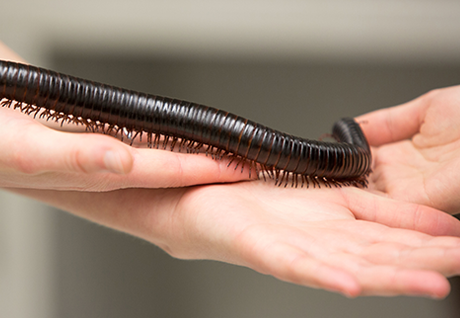
What else? “Millipedes!” LaBarbera suddenly remembers his two pet millipedes, one of them a foot long and as big around as a man’s thumb. Left over from a class he taught a couple of years ago, now they spend most of their time in a terrarium in his office, munching on green peppers and slumbering among the moss, but today they’re here, in their little traveling cases. Millipedes, LaBarbera likes to say, are basically invertebrate cows: harmless, herbivorous, vaguely lumbering. (Their centipede cousins, by contrast, are more like cheetahs: nocturnal predators that chase down their prey and stab them with fangs attached to poison glands.) “We’ll play with the millipedes after everybody is finished with the dissection,” he tells the students, by which he means, let the millipedes walk from student to student across hands and fingers and arms. All those tiny legs, all moving at once. “Those of you who have been in my biodiversity class know how much fun it is to have giant millipedes crawling up your arm,” LaBarbera says, beaming. He’s completely serious. “Truly, it feels like magic fingers.”
And finally, if there’s time, he’ll take out the grand dame from the big tank up front, the female horseshoe crab, with a shell a foot across, another veteran of a previous class. He’ll turn her belly side up (she doesn’t mind, he says) and feed her a wedge of shrimp (she loves shrimp) and maybe a live earthworm so the students can see how she chews with her powerful back legs, tearing and churning the food as she marches it toward her mouth.
“All right,” LaBarbera says, winding down. “We’re not doing the arthropods justice in any sense at all, but it’s still a busy lab. So get to it.” Breaking off into pairs, the students head first for the trays of crayfish.
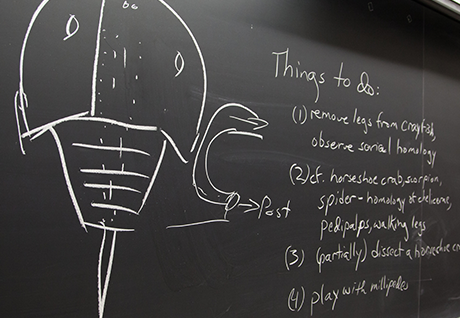
This December, after 36 years at the University of Chicago, LaBarbera is planning to retire. It will leave a hole. He’s one of those professors whose class you take just because he’s teaching it. Maybe you think invertebrate biology sounds boring, or maybe you’re not exactly sure what “biological fluid mechanics”—the title of another course and, incidentally, LaBarbera’s research specialty—even means, but it doesn’t matter; you sign up anyway. “He makes everything interesting,” says fourth-year Andrew Burchill. “Whenever there’s been a class offered that he’s teaching, I’ve taken it.” Burchill has taken four, including this fall’s Invertebrate Biology. That’s not as unusual as it sounds.
Many students’ first encounter with LaBarbera is in a course he teaches in the spring called Biodiversity. It’s basically the story of all life on Earth, compressed into ten weeks. Midway through, LaBarbera gives the students waders and dip nets and takes them out to the Jackson Park lagoon, where they spend an hour and a half dredging up whatever moves: fish; flatworms; leeches; freshwater insect larvae from dragonflies, damselflies, and mayflies. They take samples of the water, which they bring back to the lab and put under a microscope to try and identify all the teeming, crawling organisms within. Students are always amazed—and sometimes a little horrified, LaBarbera says—to see just how crammed with life their microscope slides are.
An expert in the biomechanics of marine invertebrates, LaBarbera joined the faculty in 1978, teaching in organismal biology and anatomy, geophysical sciences, the Committee on Evolutionary Biology, and the College. Especially the College. There’s enormous satisfaction and reward in graduate-level teaching, LaBarbera says, but undergraduate education is “the heart and soul of it.” You have to work harder to get the students interested, but then they’ll jump in with both feet. You watch them discover what they can do. You help them get there.
Most students call him “LaB,” an old grad school nickname he resurrected when he found that some students were tripping over the syllables of his last name. Unable to say “LaBarbera,” they would retreat to “Professor.” “I didn’t like the wall that immediately went up,” he says. Switching to LaB brought the wall back down. “They’re willing to say, ‘Hey, LaB, I don’t understand what’s going on here.’”
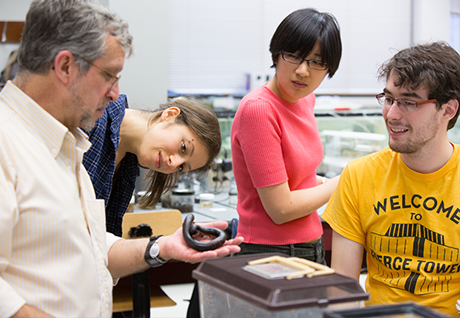
Ask College students what they like so much about his classes, and they’ll tell you how much fun his labs are, how generous he is with his time, how it’s almost impossible to ask a question he can’t answer, no matter how odd or esoteric. Fourth-year Chelsea Leu notes that last fall he offered to read drafts of students’ papers and give comments for revision before they handed them in for a grade. As many drafts as they could turn out before the due date, he would read and hand back. “Which I have never had any professor do, ever,” Leu says. Plus, says Andrea Rummel, another fourth-year: “I mean, the millipede. I love that. It’s like the most random, kind of specialist animal you could keep for a pet.”
But part of what draws students in is something else, an idea that also animates LaBarbera’s own research and sends him chasing after new questions sometimes while he’s still answering the last one: it’s the sense that science is a shared adventure, one that his students can take part in, that it’s a story always being written and rewritten. “Which is the truth in all science, but usually no one presents it like that,” Burchill says. “So something like taxonomy, which is usually considered pretty dry, he presents it like a mystery that we’re working on. Like, ‘We’re not done yet.’ And we’re not—taxonomies sometimes change. But it makes you curious. At the end of every class, I always come away like, ‘What’s going to happen in the next class?’”
Sometimes the intellectual adventures seem inseparable from more tangible ones. For instance: the gigantic Humboldt squid with ten-foot tentacles that washed ashore one summer near the Puget Sound marine lab where LaBarbera was working. “We dissected this thing in a driveway,” he told his students, who at that moment were hunkered over their own squid dissections with tweezers and clippers. “It was really fun. It took us all day. You don’t see these specimens very often. Everybody was in there taking samples and studying the morphology.” Instead of the rings of teeth that line the suckers of smaller squids’ tentacles—the suction presses the teeth into the prey’s flesh, making the squid’s grasp inescapable (“such a cool adaptation”)—the Humboldt had hooks, LaBarbera said. “Literal hooks.” He seemed amazed all over again.
Among the shells on display in the lab that day was one from a giant clam about a foot and a half wide. LaBarbera brought it home from Fiji himself, snorkeling down 25 feet to get it. Swimming back up with it, he nearly drowned. “They get rid of predators by squirting water at them,” he told the students gathered around him, “so I had this clam under my arm, and it was going, whoosh! Whoosh! And shooting this rocket of water up. And every time I would kick we would go up, and every time it would close, we would go down, and I wasn’t sure I was going to make it.” He paused. “Anyway. This is my giant clam.”
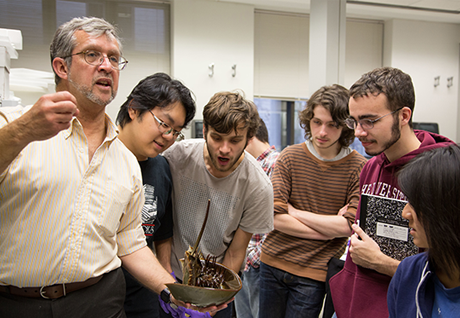
A week later, during a lecture on annelids, the phylum of segmented worms, talk turned to the odd kinship between earthworms and leeches. LaBarbera was explaining how leeches, with their suckers and jaws, are a sister group to earthworms, except they’ve undone many of the evolutionary complexities of those “fancy worms”—the segmented body cavities, the high-efficiency locomotory apparatus. “What leeches do is lose all of that. … So they basically turn into flatworms with mesenchyme”—loosely packed, relatively undifferentiated cells—“filling in the spaces.” Why? He told students to think about it and offered a hint: “It has to do with the way they locomote.” Which reminded LaBarbera of a story about the big mountain pond in northern Uganda where, during grad school, he and another student were taking sediment samples and suddenly discovered that their canvas boat was crawling with leeches. The animals were coming over the side. “They were so hungry, they were coming after us,” LaBarbera said. “The scariest thing I’ve ever seen in my life.” Yet he was grinning again.
And that’s the thing. LaBarbera’s affection for animals—all animals—is enormous. For him, there seems to be something wonderful and exhilarating in almost every encounter. That’s why he’s forever taking pictures, carrying his camera to Botany Pond, Jackson Park, Washington Park, and to faraway oceans across the world. In the lab, he keeps a tripod trained on the aquariums, waiting to catch a flower-like phoronid with its tiny mouth open, or a barnacle with its feathery legs extended. (“This is what is captivating me in my old age,” he says, the beauty and strangeness of the natural world. Retirement will allow him more time behind the camera; he has at least one photography expedition already on his calendar.)
LaBarbera’s love for animals is warmly generous and familiar, even intimate, but it’s also a scientist’s love: clear-eyed, unsentimental, without romantic illusions. He understands how an animal is working, what it needs, what it’s trying to do. What its world looks like.
LaBarbera is also the guy people call when they find an animal on campus hurt or lost, or just in the wrong place—like, say, when a snapping turtle gets into Botany Pond and starts menacing the fish, or a duckling escapes, or wanderlust overtakes the painted turtles and they start heading toward the road. (Spring, he says, is a busy time of year; whenever he hears the phone ring, he reaches for his net.) He also gets calls about birds that fall to the ground after flying into buildings: “We’re on a major north-south flyway,” he says. “Birds that fly up to Canada come up along the lake, and they stop in Hyde Park because of Jackson Park and Washington Park, these semiwild areas.” From the air, the whole neighborhood looks like a forest; trees everywhere, with the occasional roof and spire peeking through the canopy.
Other faculty call LaBarbera when they have animals they can no longer keep and don’t want to kill. A researcher came in recently with some Daphnia left over from a study on heart rates; one afternoon this past fall, a postdoc from another lab showed up with a pleading look and a Styrofoam cooler full of starfish and sea urchins. “I’m the guy that takes care of everybody else’s animals,” LaBarbera says. “Anything that’s aquatic, and especially aquatic and invertebrate—that’s mine. Everybody knows. Just call me up.” He’s inherited a couple of fish and some corals from an aquarium upstairs. Some years ago, he took in an injured baby softshell turtle after a former student rescued it from the jaws of a snapping turtle at a Field Museum laboratory, prying the frightened animal loose with a screwdriver. That one LaBarbera took home to his wife and two daughters, where it joined an ever-evolving collection of pets that has included, at one time or another, fish, lovebirds, parakeets, ferrets, gerbils, guinea pigs, a tortoise, and a hamster. “We’ve always had a houseful,” he says.
LaBarbera’s wife, Maggie Hivnor, AM’77, is the paperback editor at the University of Chicago Press. His youngest daughter, Claire, U-High’10, is in college, and his oldest, Katie, U-High’06, is a PhD student at Berkeley, where she studies behavioral ecology. The first sign of her scientific disposition, LaBarbera says, came when she was seven years old and one of the family parakeets died. “She said, ‘I miss the bird so much,’” LaBarbera recalls. And then, knowing that her father knew taxidermy, she asked, “‘Dad, can’t you stuff it?’ And I foolishly said, ‘Sure.’ So we had this long afternoon in which we skinned this poor parakeet and I proceeded to prepare the skin and stuff it.” There’s an art to taxidermy; you have to cut the legs off and clean out the skull while keeping it intact. Everything else—bones, organs, viscera—comes out, and then the body is packed with cotton. “It’s pretty gruesome,” LaBarbera says. “But Katie was right in there, watching every step. … I thought a seven-year-old would chicken out as soon as I started peeling back the skin.” At Berkeley Katie LaBarbera studies the dark-eyed junco, a species of sparrow. Her stuffed parakeet is in a drawer back home in Hyde Park.
From the time he was in middle school, LaBarbera wanted to be a biologist. Paleontology was the thing that hooked him first. “Because I grew up in upstate New York, surrounded by all these wonderful Devonian formations,” he says. “There, you kick a rock, and it’s a brachiopod.” In eighth grade, he discovered zoologist Libbie Hyman’s The Invertebrates (McGraw-Hill, 1940) at the public library, an exhaustive multivolume compendium that Hyman, SB 1910, PhD 1915, devoted the last decades of her life to writing (the sixth and final volume came out in 1967, when LaBarbera was in college and Hyman was 79). He read the whole thing cover to cover, encountering strange and fascinating creatures. The Invertebrates had loads of pictures, although some of them were less than elegant—mostly they were line drawings taken straight from journal articles. But they were endlessly detailed and scrupulously annotated. “Hyman labeled everything,” LaBarbera says: every joint and appendage and tissue and lobe. Every tentacle, every papilla, every ventral groove. He spent hours lost in those pages, deciphering each organism, structure by structure.
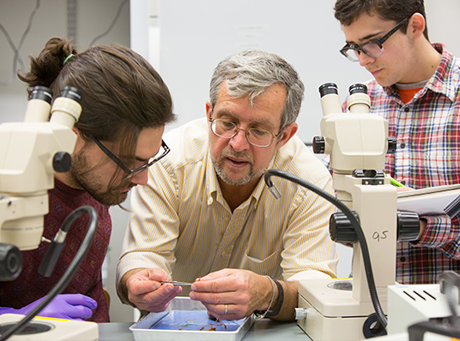
The marine animals were the ones that interested him most. They seemed so otherworldly, with their alien shapes and bizarre formations. This, he realized, was where the real diversity was. “I was absolutely captivated by the cnidarians,” he says. That group includes corals, jellyfish, and sea anemones. For a kid living in a one-stoplight town far from the ocean, “sea anemones and corals were the ultimate exotics—wonderful beasts that did so much with so little.” The cnidarian body plan is surprisingly simple: two layers of cells separated by a gelatinous substance that acts as a kind of flexible internal skeleton. Essentially, they are a sac within a sac. “We got some occasional fossil corals in my neighborhood,” LaBarbera says, “but I’d never seen any of these animals alive.” Hyman’s depictions set his mind on fire.
And so in 1966 LaBarbera enrolled at Cornell University as a marine biology major, having never seen the ocean. “It was kind of this magic thing that I was just intrigued by,” he says. He finally got there the summer after his junior year, on a research fellowship at the Virginia Institute of Marine Science, an academic laboratory on a little jut of land on the Chesapeake Bay. The following year, an oceanography course took him on a cruise to the Sargasso Sea.
After Cornell, he went to Duke, where he studied with Steven Vogel, a founding scholar of modern biomechanics. A relatively small discipline, it suited LaBarbera’s conceptual-yet-in-the-mud-up-to-his-elbows approach to science. Biomechanics studies the structure and function of living systems using methods taken from mechanics, which analyzes the effect of forces on the motion of bodies. There’s physics in biomechanics, and more than a little engineering. Kristin Sherrard, SM’00, PhD’03, a former graduate student of LaBarbera’s, explains: “Biology can be very descriptive, or it can be very quantitative and technical.” Biomechanics makes it possible to do both, examining how an organism’s structure influences its ability to survive and reproduce.
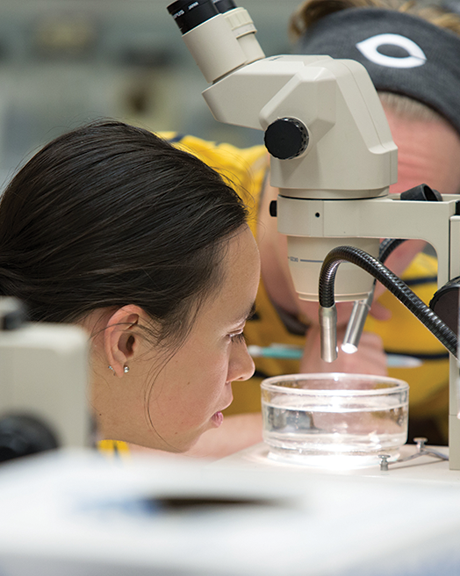
In lab one afternoon, LaBarbera and his students crowd around a dish of yolky, translucent eggs, from which cuttlefish are hatching. The room goes silent as one of the eggs begins to quiver and break open. Gasps. “Oh, he came out!” says grad student Carrie Albertin, SM’12, who’d brought the eggs over from a lab down the hall, along with a newly hatched octopus in another dish. Each newborn is perhaps half an inch long, maybe less; the cuttlefish, a Metasepia pfefferi, changes colors furiously as it emerges: yellow, red, purple, white, brown. With its ribbonlike arms billowing, it looks almost like a tiny shifting flame in the water. The newborn octopus, curled and motionless, waits at the bottom of its dish.
In the wild, octopuses are on their own from the moment they hatch, because adults do not survive after reproduction. The male dies after fertilizing the eggs—an elaborate process that often involves a detachable sperm-carrying tentacle, which swims through the water independently. The female broods the eggs for as long as she can, forgoing food and losing strength until she dies. In her lab, Albertin says, the female usually stays alive until about ten days before her eggs hatch. A strange and tragic lifecycle, adds LaBarbera, for an animal of such intelligence. “Cephalopods are the invertebrates that most closely approximate vertebrates in terms of intelligence and learning ability,” he says. Their brains are huge, and hugely complex, with nerve cords extending into each of their eight arms. “In terms of basic intelligence, it’s hard to compare animals, but estimates I’ve seen say that your average good-sized octopus is about as intelligent as your average good-sized cat.” He pauses. “Which is not bad for an animal whose nearest relative is a snail.”
A student asks LaBarbera why octopuses became genetically programmed to die.
“We don’t know,” he says. “Best guess is that it’s an accident of their evolutionary history.” At some point there must have been advantages in investing everything it had into one brood. “It’s now built into the hormonal system,” LaBarbera says, “so the only way to extend the life of the octopus is to go in and remove organs that normally secrete hormones associated with brooding and mating. If you do that, they will live longer, but they’re not the same. They just kind of turn into vegetables. It’s really sad.”
He wonders what would happen if octopuses had “cultural transmission,” if adults could teach things to their young. Put two octopuses in adjacent tanks, and one will watch the other and learn from it, he tells the students. “If there was generational overlap, they could give us real competition.” He trails off.

LaBarbera’s biomechanics research focuses on fluid dynamics, and often—because that childhood curiosity about the Devonian fossils in upstate New York never left him—the fluid dynamics of long-dead species. Years ago, when he wanted to test whether a mathematical formula called Murray’s law, which predicts the relative size of blood vessels in a branching network, held up in invertebrates, he started with a 60-million-year-old fossilized sponge. (Then he moved on to earthworms, horseshoe crabs, bivalves, and blue crabs.) Murray’s law worked, he found, after some initially confounding results.
More often than not, LaBarbera’s research has him building models of extinct marine animals, which almost inevitably he ends up submerging in the ocean somewhere, to see what happens out in the wild. To see how they might have behaved, what they did to eat and survive, what their worlds looked like.
He’s famous for his models. “Elegant,” is how former gaduate student Paul Magwene, PhD’99, describes them: Mesozoic clams with shells shaped like giant ice-cream cones; oysters from the Cretaceous; plant-like echinoderms called blastoids, with long stalks and hundreds of arms radiating out from small kerneled bodies. Extinct for 250 million years, blastoid fossils now litter the Midwest. LaBarbera’s blastoid model, with its wire stalk and 570 red bristled arms (“I counted,” he says), sits atop his desk.
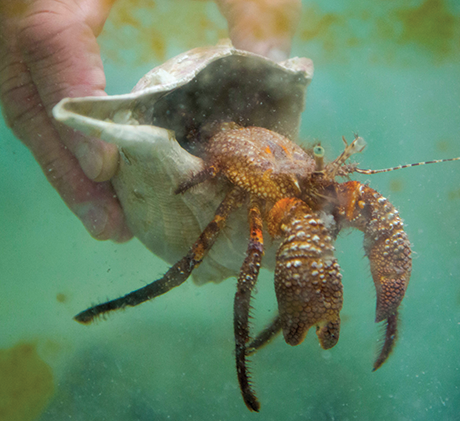
His office, on the first floor of Culver Hall, with a window overlooking Botany Pond, resembles a machine shop, with equipment and construction materials scattered everywhere—saws, drills, electrical wiring, a bucket of epoxy, a can of WD-40. Aquariums crowd one corner. The whole place seems emblematic of LaBarbera’s approach to his work. His colleague Susan Kidwell, who teaches in geophysical sciences and also studies marine fossils, describes that approach. He’s able to “simplify,”she says—conceptualizing complex animals as machines with measurable variables—but he’s also “completely willing to leave it messy.” That’s why LaBarbera takes his models to the ocean, not relying solely on tests in specialized flow tanks with controllable forces. “You simplify, you look at one variable,” Kidwell says, “but you still look at it in the natural world, so it’s got the whole messiness of the natural world.” As useful as it is to think about animals as machines, they’re still animals, living in environments that aren’t always predictable. It helps to see models in real marine conditions, even models of prehistoric animals in modern-day seas. As LaBarbera says, “Let’s just see what happens.”
In his classes, both graduate and undergraduate (Kidwell and LaBarbera have cotaught College field courses in Mexico and the Bahamas, where students conduct their own research projects), LaBarbera passes on this sensibility. Sherrard describes his willingness to let students make instructive mistakes and attempt things that may not lead anywhere. She once spent several months on an experiment that yielded no data; the effort, she says, was still valuable. Magwene, who switched dissertation topics midway through his studies, from limbless lizards to turtles, says the independence to explore, even blind alleys, was important to his education. “Mike makes the students so fearless about trying things,” Kidwell says. “But also, they learn how to think, and how to conceptualize a problem and turn it into something doable and testable.”
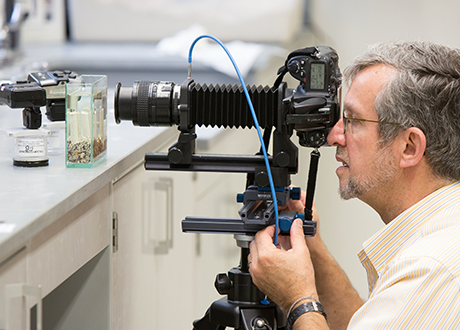
On the day before his arthropod lab, LaBarbera is in his lab by noon. This week’s live animals have arrived, shipped from the Gulf of Mexico in a giant Styrofoam cooler, each sealed in its own plastic bag full of water. All those crabs and shrimp—which he pulls out one by one, greeting them merrily, “Hi there! Good to see you, little guy”—are hungry and tired. LaBarbera will spend the next three or four hours slowly acclimating each animal to its new habitat in the aquariums: opening the bags to let in fresh oxygen, incrementally adding water from the tanks, careful not to stress the creatures with abrupt changes in temperature or salinity. “I want the shock to be minimal,” he says.
With his TA, Liam Heins, AB’13, LaBarbera ventures up to the fourth floor where the preserved specimens are stored, in a narrow windowless closet crammed floor to ceiling with dead creatures, staring out opaquely from jars of formaldehyde. “Here’s the house of horrors,” LaBarbera says cheerfully, swinging open the door. Scanning the shelves, he hands jar after jar to Heins, who places them on a cart to wheel back to the lab: scorpions, tarantulas, sea spiders, gooseneck barnacles, a mantis shrimp. “Some of these specimens are just ancient,” LaBarbera says. “That thing up there?” He points to a jar on the top shelf containing cross sections of an eel-shaped, rasp-faced hagfish. “That’s probably 100 years old.”
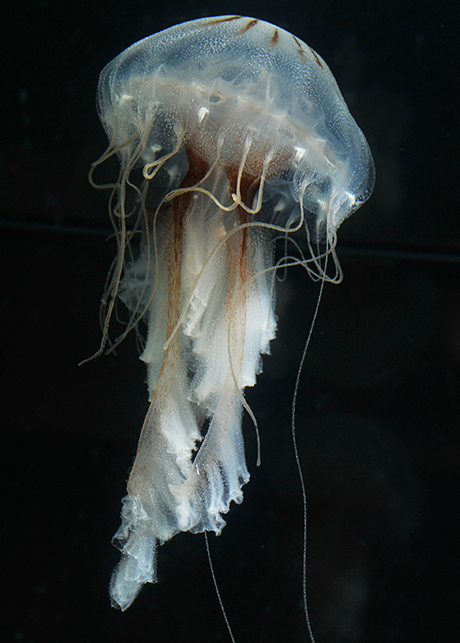
Back downstairs in the lab, the live animals are ready for full immersion. Fiddler crabs, set up in a tank that simulates a sandy beach, are already building their burrows. In the back corner, Heins organizes the trilobite fossils. LaBarbera gets out the microscope slides of insects and crustaceans, some of which he made when he himself was an undergraduate, from specimens collected on that trip to the Sargasso in 1969. “M. LaBarbera,” they read, in miniature black script.
“When students come in, all of this is transparent,” he says. They never know how much work goes into each lab.
One last check around the room to make sure everybody’s fed and happy and settled. It’s nearly four o’clock. “All right,” LaBarbera says. “I’m out of here. I think we’re ready for tomorrow.”
